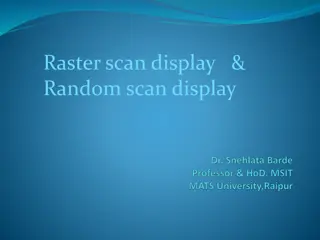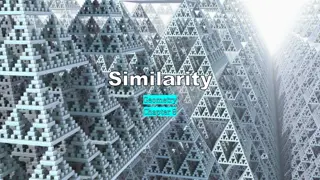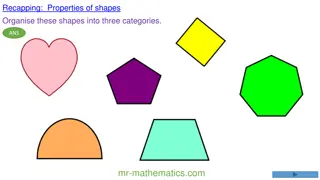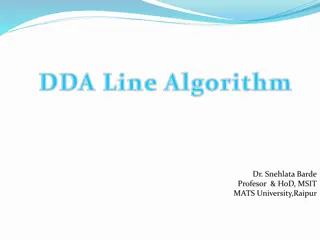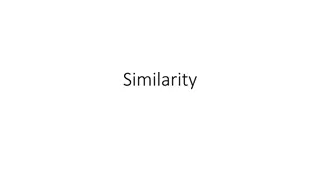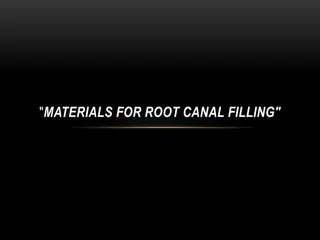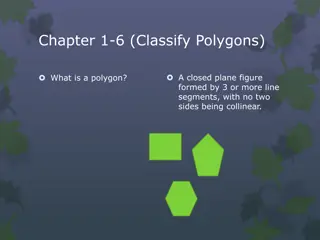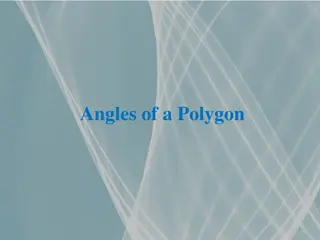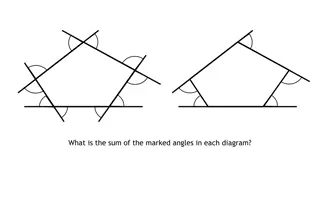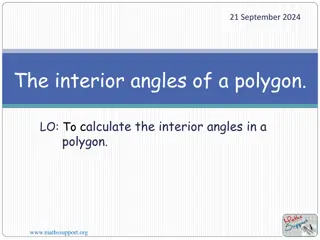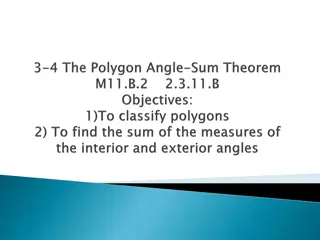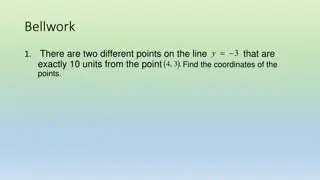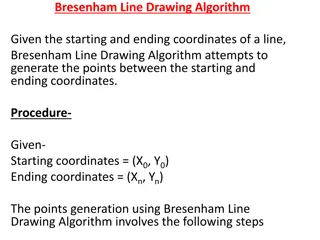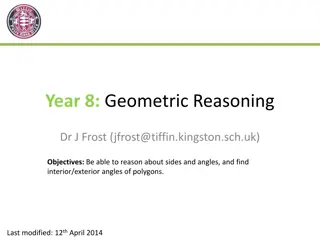Filling Polygons Using Scan Line Algorithm
Learn how to fill polygons using the Scan Line Algorithm, which involves intersecting scan lines with polygon edges and filling the area between intersections. Steps include finding Ymin and Ymax, intersecting scan lines with edges, sorting intersection points, and filling the interior of the polygon based on pairs of coordinates. Explore techniques for filling polygon areas and boundaries with different colors, relying on Four-connect or Eight-connect methods. Understand the process of filling pixels within the polygon's interior by looking for adjacent pixels. Discover boundary fill algorithms using 4-connected or 8-connected pixels.
Download Presentation

Please find below an Image/Link to download the presentation.
The content on the website is provided AS IS for your information and personal use only. It may not be sold, licensed, or shared on other websites without obtaining consent from the author.If you encounter any issues during the download, it is possible that the publisher has removed the file from their server.
You are allowed to download the files provided on this website for personal or commercial use, subject to the condition that they are used lawfully. All files are the property of their respective owners.
The content on the website is provided AS IS for your information and personal use only. It may not be sold, licensed, or shared on other websites without obtaining consent from the author.
E N D
Presentation Transcript
Polygon is an ordered list of vertices as shown in the above polygons with particular colors, you need to determine the pixels falling on the border of polygon and those which fall inside the polygon. Now, we will see how we can fill polygons using different techniques. figure. For filling
Scan Line Algorithm This algorithm works by intersecting scanline with polygon edges and fills the polygon between pairs of intersections. The following steps depict how this algorithm works. ScanLine
Step 1: Find out the Ymin and Ymax from the given polygon. Step 2: ScanLine intersects with each edge of the polygon from Ymin to Ymax. Name point of the polygon. As per the figure shown above, they are named as p0, p1, p2, p3. Step 3: Sort the intersection point in the increasing order of X coordinate i.e. (p0, p1), (p1, p2), and (p2, p3). Step 4: Fill all those pair of coordinates that are inside polygons and ignore the alternate pairs. each intersection
Sometimes we want to fill the area of polygon and its boundary with different colors. it relies on the fill color. In other words, it replaces the interior color of the object with the fill color. When no more pixels of the original interior color exist, the algorithm is completed.
This algorithm relies on the Four-connect or Eight-connect method of filling in the pixels. But instead of looking for the boundary color, it is looking for all adjacent pixels that are a part of the interior.
In this algorithm, we assume that color of the boundary is same for the entire object. The boundary fill algorithm can be implemented by 4-connetected pixels or 8- connected pixels.
In this technique 4- connected pixels are used as shown in the figure. We are putting the pixels above, below, to the right, and to the left side of the current pixels and this process will continue until we find a boundary with different color.
Algorithm Step 1: Initialize the value of seed point (seedx, seedy), newcolor and ololdcol. Step 2: Define the boundary values of the polygon. Step 3: Check if the current seed point is of old color, then repeat the steps 4 and 5 till the boundary pixels reached. If getpixel(x, y) = ololdcol then repeat step 4 and 5 Step 4: Change the old color with the fill color at the seed point. setPixel(seedx, seedy, newcol)
step 5: Recursively follow the procedure with four neighborhood points. FloodFill (seedx 1, seedy, newcol, oldcol) FloodFill (seedx + 1, seedy, newcol, oldcol) FloodFill (seedx, seedy - 1, newcol, oldcol) FloodFill (seedx 1, seedy + 1, newcol, oldcol) Step 6: Exit
There is a problem with this Consider the case as shown below where we tried to fill the entire region. Here, the image is filled only partially. In such cases, connected technique cannot used. technique. 4- pixels be
used as shown in the figure. We are putting pixels above, below, right and left side of the current pixels as we were doing in 4- connected technique. In this technique, 8-connected pixels are
In addition to this, we are also putting pixels in diagonals so that entire area of the current pixel is covered. This process will continue until we find a boundary with different color.
Recursively follow the procedure with eight neighborhood points. FloodFill (seedx 1, seedy, newcol, oldcol) FloodFill (seedx + 1, seedy, newcol, oldcol) FloodFill (seedx, seedy - 1, newcol, oldcol) FloodFill (seedx, seedy + 1, newcol, oldcol) FloodFill (seedx 1, seedy + 1, newcol, oldcol) FloodFill (seedx + 1, seedy + 1, newcol, oldcol) FloodFill (seedx + 1, seedy - 1, newcol, oldcol) FloodFill (seedx 1, seedy - 1, newcol, oldcol)
This method is also known as counting number method. While filling an object, we often need to identify whether particular point is inside the object or outside it. Odd-Even Rule method is used by which we can identify whether particular point is inside an object or outside. counting number method.
In this technique, we will count the edge crossing along the line from any point (x,y) . If the number of interactions is odd, then the point (x,y) is an interior point; and if the number of interactions is even, then the point (x,y) is an exterior point. The following example depicts this concept.
(x, y) (x, y)
Rotating About An Arbitrary Point Rotating About An Arbitrary Point 20
What happens when you apply a rotation transformation to an object that is not at the origin? Solution: Translate the center of rotation to the origin Rotate the object Translate back to the original location
Rotating About An Arbitrary Point y y x x y y x x




